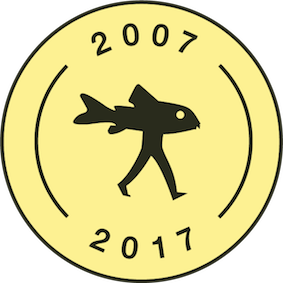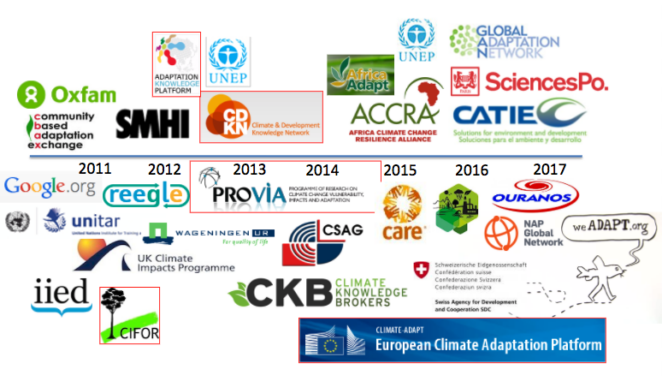Happy 10th birthday, weADAPT! Celebrating the history and future of the climate adaptation network

weADAPT in retrospect
The walking fish has come a long way in its 10-year-long journey! This visual symbol of weADAPT conveys the sense of evolution and sense of purpose that emerges by traveling step by step. These are central to the weADAPT vision, journey and history.
Over the past 10 years weADAPT has grown from being the brainchild of a handful of UK-based climate adaptation researchers curating content for the web platform, to a network that encompasses a global community of researchers, practitioners, advocates and policy-makers sharing the work they do, questions and challenges they face, and the lessons they learn on issues relating to climate adaptation in all corners of the world.
weADAPT has evolved from a mere idea, to a few articles on a wiki, and then to a multi-functional web platform that integrates with other platforms (such as the Climate Information Portal), and powers customised websites targeting particular audiences (such as the “Energy Adaptation Map”).
In short, weADAPT has proved that its hallmark characteristic is – appropriately enough – adaptability.
Throughout all this change, key missions have remained the same. An email sent to early advocates in June of 2007, when weADAPT was just beginning, listed key aims – items that eventually evolved into our “adaptation principles”. A read of this list a decade later shows – strikingly – how relevant they remain in light of how the science and practice of climate adaptation have developed over the last decade.
As we said in our first days, our approach to climate change involves:
- Collecting and integrating spatial quantitative and qualitative data on current vulnerability;
- Analysing climate conditions and trends;
- Calculating thresholds of exposure to climatic risks in a variety of sectors or groups;
- Charting envelopes of climate scenarios for critical thresholds;
- Estimating sensitivity of adaptation options to future conditions; and
- Screening options using simple, clearly defined methods whenever possible, while providing more complex models where required.
weADAPT has been at the leading edge of fostering, capturing and sharing new developments in the field of climate adaptation, linking theory, policy and practice across scales and places. The story of how we chose the weADAPT name offers the best sense of the spirit of the enterprise. Our early development began in the days when Apple was rapidly becoming the international icon of innovation and high-tech simplicity, with the iPod dominating the market and the iPhone just being released. This provided a source of inspiration, and the first proposed name for the platform, iADAPT. But we quickly argued that for climate adaptation to work it couldn’t be an individual pursuit. Instead the mission relies relied on collaboration, coordination and collective effort. Because the scale of action required to address climate change is well beyond any individual or organization the nature of such action and learning has to be shared; hence, not the solitary iADAPT but the communal, weADAPT. This distinction was then – and, 10 years on, still is – central in all we do.
Read more about weADAPT’s history – as described by two of its founders – in the featured download, available from the right-hand column.

weADAPT looking forward
The last 10 years have been a wonderful experience and a great success, and we aim to make the next 10 years even more so! 2017 has been an exciting year for weADAPT.
The launch of our new service supporting the development of individually branded websites on top of weADAPT technology responds to needs long-identified by our knowledge partners. This service has finally seen fruition thanks to the Ouranos Consortium and their “Energy Adaptation Map”, which brings together case studies highlighting the importance of and barriers to adaptation in the energy sector.
A knowledge legacy collaboration with USAID’s Adapt Asia-Pacific project has brought a wealth of expert training materials and project preparation guidance to weADAPT, and our ongoing collaboration with partners such as the Swiss Agency for Development and Cooperation’s (SDC) Climate & Environmental Network continues to bring important insights to the platform. This is all in addition to all our invaluable contributions from users, which continue to increase year-on-year.
But we have more in store! Respondents to our weADAPT User Survey have asked about online learning materials and training through weADAPT. This is an area we are now exploring with the help of collaborators at the University of Ohio in the United States, Makerere University in Uganda, and the Independent University in Bangladesh, the latter of which are initiating partners in the Least Developed Countries Universities Consortium on Climate Change (LUCCC). Respondents have also asked whether we can share more content relating to agriculture and water use. We are investigating ways to address this request.
These issues underscore an important point: we want to hear from you! weADAPT was developed to support the adaptation community as a whole, so we would like to know what you want from our online network, community and services – which are in a state of perpetual adaptation themselves. You can have your say in our weADAPT User Survey. We are particularly keen to better support small NGOs and community-level organisations, which are an essential part of a proactive adaptation community that not only discusses good practice but supports its implementation on the ground. If you have any pointers for us, please let us know in the survey or get in touch with us at [email protected].
(0) Comments
There is no content